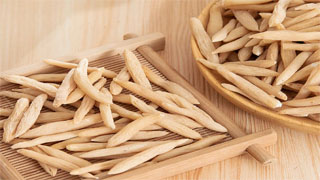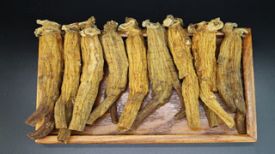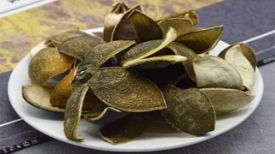
1. Alias
Mai Men Dong, Yan Jie Cao, Immortal Medicine, Yu Yu Yu's surplus grain.
2. Plant morphology
Perennial herb. There are slender creeping branches underground, membranous bracts on the nodes, and fibrous roots that often have partially swollen into fleshy tubers. Leaves clustered, narrow linear, apex blunt or sharp, base narrow, petiole sheath like, with thin films on both sides. Terminal inflorescence; Bract membranous, with 1-3 flowers per bract axillary; The flowers are light purple, occasionally white, small in shape, slightly drooping; 6 pieces of flower quilt, unfolded, oval shaped; Stamen 6. The filaments are not obvious, shorter than the anthers, and the tips of the anthers are pointed; Ovary semi inferior, 3-chamber. Berry, spherical, early green, dark green or blue black when mature. The flowering period is from May to August, and the fruiting period is from July to September.
3. Origin distribution
Born on damp slopes, under forests, or by streams below an altitude of 2000 meters. Distributed in Shandong, Anhui, Zhejiang and other places.
4. Harvesting and processing
In the third year after cultivation in Zhejiang, it is harvested during the beginning of summer and called 'Hangmaidong'. After digging up the Ophiopogon japonicus, cut off the root tubers, wash the soil, sun dry for 3-4 days, stack in a well ventilated area to allow it to regain moisture and evaporate water vapor. After about 3 days, spread it out and sun dry again, repeating this process 2-3 times. After drying, remove any impurities from the roots.
5. Characteristics of medicinal herbs
Spindle shaped or oblong, slightly pointed at both ends, filled or slightly contracted in the middle, 1.5-3 cm long, 3-6 cm in diameter. The surface is yellow white or light yellow, with irregular longitudinal wrinkles. When not fully dried, the texture is relatively soft, but after drying, it becomes hard and brittle, and is prone to breakage; The broken surface is yellow white, with a keratinous appearance and a small central pillar. The aroma is slightly fragrant, and the taste is slightly sweet.
6. Sexual Taste Returning to the Classics
Slightly cold in nature, sweet and slightly bitter in taste. Returning to the Heart Meridian, Lung Meridian, and Stomach Meridian.
7. Effect and Function
Nourish yin and generate fluids, moisten the lungs and clear the heart. It belongs to the category of tonifying yin medicines under the category of tonifying deficiency medicines.
8. Clinical application
Take 6-12 grams of decoction orally; Or into pills, powders, or creams. Apply in moderation for external use, adjust and apply after grinding; Fried soup coating; Or apply fresh mashed juice. Used to treat dryness of the lungs, cough, vomiting blood, lung abscess, deficiency, fatigue, heat, thirst, fever, fluid injury, dry throat and mouth, constipation, etc.
9. Pharmacological research
Has a protective effect on the cardiovascular system; Enhance hypoxia tolerance and prolong survival time under atmospheric hypoxia; Enhance immune function; Lowering blood sugar levels; Delaying aging; Inhibit gastrointestinal motility; Antibacterial. Ophiopogon japonicus is a good yin nourishing and lung moistening medicine, and in recent years, it has been found to have a good effect on lowering blood sugar; The clinical application of cardiotonic effect is stable and effective. The experiment also proved that water-soluble polysaccharides in Ophiopogon japonicus have anti hypoxia and immune promoting effects.
10. Chemical composition
Containing various steroidal saponins, with Ophiopogon japonicus saponin A having the highest content, followed by Ophiopogon japonicus saponin B; In addition, it contains various high isoflavones. Five flavonoids were isolated and identified from Zhejiang Ophiopogon japonicus. In addition, it also contains Ophiopogon flavonoids A, Rosco saponin, Diosgenin, Ophiopogon flavanone, α - patchoulin, ethyl hexadecanoate, oleanolic acid, etc.
11. Usage taboos
It is contraindicated for patients with diarrhea caused by deficiency cold, obstruction caused by dampness and turbidity, wind cold or cold phlegm coughing and wheezing.
12. Compatibility prescription
① Treating lung dryness and cough: 15g of Ophiopogon japonicus and 15g of mulberry bark. Boil it in water. (New Handbook of Commonly Used Chinese Herbal Medicines)
② Treatment of lung heat cough: 12g Ophiopogon japonicus, 12g Panax notoginseng, 9g Scutellaria baicalensis, 9g Platycodon grandiflorum, 9g Almonds, and 6g Licorice. Boil it in water. (Shandong Herbal Medicine Handbook)
③ Treatment for gastric acid deficiency: 6 grams each of Ophiopogon japonicus, Dendrobium officinale, and Vitesse, and 9 grams of glutinous rice roots. Boil it in water. (Fujian Pharmaceutical Journal)
④ Treating otitis media: Mash the fresh Ophiopogon roots and extract juice, then drip it onto the ears. (Selected Materia Medica of Guangxi)
⑤ Treating urinary obstruction: 90g fresh Ophiopogon japonicus (30g dry). Boil in half a cup of water, take before drinking, 2-3 times. (Fujian Folk Herbal Medicine)
⊙ The content of the article is for clinical reference only. Non TCM professionals are not allowed to test drugs.


